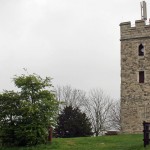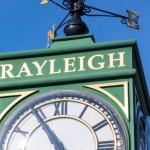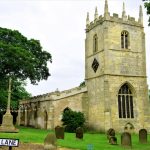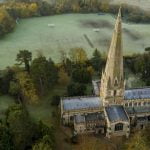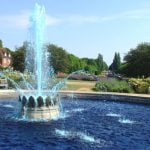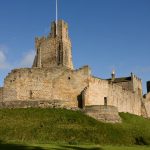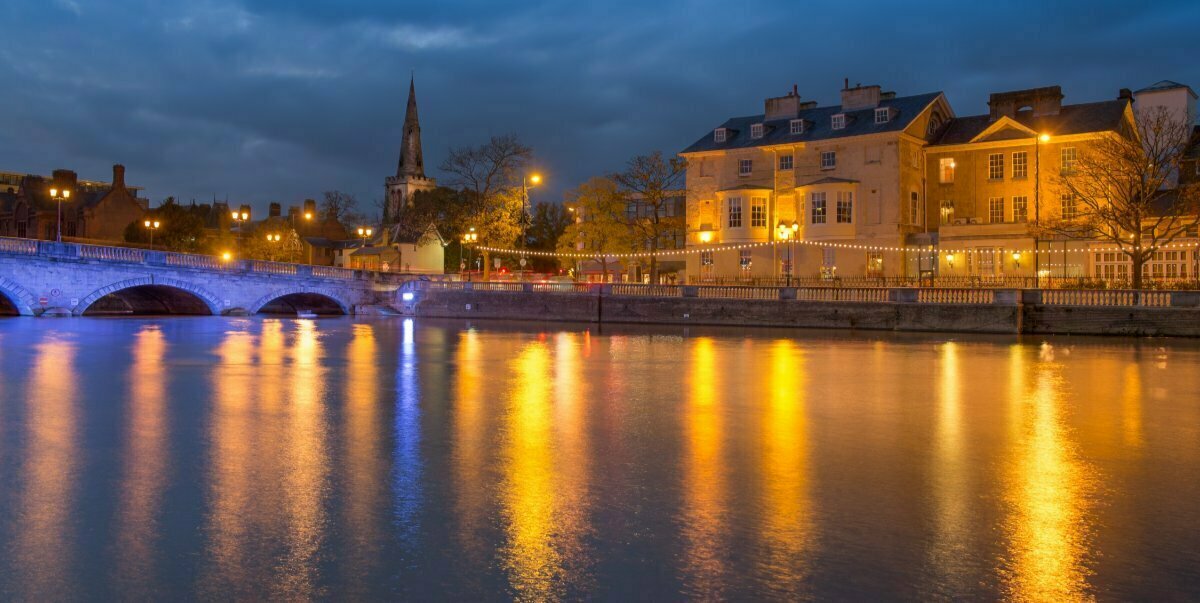
Bedford is an idyllic English riverside market town located in the unspoilt countryside of Bedfordshire. It is only 46 miles north of London so forming part of the Capital’s commuter belt and is close to both Oxford and Cambridge. Thus it makes a great base for those looking to explore London and the surrounding towns & cities.
It is also one of the countries most cosmopolitan towns and is steeped in history. It also has a strong literary bent making it an interesting place both to visit and or use as a staycation base to explore the region.
Even if you are not that keen on the cultural side there is plenty to do with a multitude of parks available and all the usual entertainment venues you would expect from a town with this stature. If sports your thing there is a Football team and of course Rowing including the Bedford Regatta which has been a feature since 1853!
Overall it has something for everyone as you will see as you read on, so without further ado here is the Five Minutes Spare verbal tour.
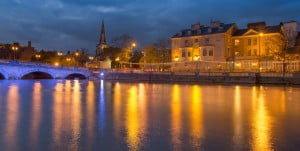
Image: Gordon Bell/Shutterstock.com
Brief History
Bedford was founded at a ford on the River Great Ouse and is thought to have been the burial place of Offa of Mercia.
King Offa or Mercia was buried here in 796. Unfortunately, they buried him on the banks of the river so that it was quick to wash him away to the sea. Offa would have been one of the Dane/English kings from a period when half of England was living under Danelaw. Incidentally, the town was on the border of Wessex – still owned by the king – and Danelaw. The Danes built a fortified settlement north of the town, but the kind burned it down.
Bedford remained a prominent border town from 886 all the way through to the 900s, when Edward the Elder built a fort there. The Dane’s quickly burned it down in their intermittent attacks. The castle would be rebuilt here, but not until after the Normans invaded in 1066. At least… that’s when they stopped burning things and started building in stone.
Early Bedford was incredibly turbulent. It was reportedly pillaged by the Danes as late as 1010, even though it was a well-defended town. Surprisingly, people still lived there, even though they knew that it might get burned. Those early Bedford inhabitants must have been hard as nails.
Bedford was granted borough status in 1165 and has been represented in Parliament since 1265.
Domesday Bedford
With all of that behind them, Bedford received a royal charter in 1166. Before that, however, the Norman invasion took place and King William the Conqueror decided to survey his kingdom. We rely on the Domesday book a lot to recount what early towns were like. Bedford was busier than most. It was so busy, in fact, that nobody bothered to record the population. In fact, all that is recorded is the owner’s name and the presence of churches.
Keep in mind that when you had churches back then, it was because there were enough people in the area to constitute a parish. The lands around Bedford recorded 2 owners, and this might explain the absence of information. King William owned one church and 1.0 church lands in Bedford. The other owner was the Bishop of Lincoln’s lands, and he owned two churches and made 4 pounds from it annually.
The idea that there were three churches should give you an idea of town size. Also, the surveyors wouldn’t have asked the church too many questions about what they were doing with the lands.
Medieval Bedford
The newly built castle was razed to the ground in 1224. It wasn’t burned, mind, it was ‘razed’. A rebelling lord captured it from the king and when the king got it back, he destroyed it. The charter granted earlier in 1166 meant that the town was a thriving market with a population of around 1500 people. It might not seem much to us, but in medieval times it was very nearly a city. People would come from all over to attend the annual fair.
As of 1238, Franciscan friars arrived in the area. They were the ones that wore grey. They settled just outside town at Caldwell Priory and there set up a leper colony. As you can tell, they were beloved by all. Bedford even sent two MPs to parliament in the latter part of the 1200s.
Middle Aged Bedford
From the early Middle Ages Bedford established itself as a pivotal market town. Bedford is steeped in history with a fortress being built by Edward the Elder on the south side of the river, which was destroyed by the Danes. The castle remains that can be visited today was built by William II, was made of much sterner stuff. This castle was finally destroyed in 1224, the Castle Mound on the Embankment being the final visible remains. This mound has been celebrated by Bedford and has recently been renovated with a mosaic at its base.
There have been many associated industries with Bedford over its history including wool during the Middle Ages and lace during the 1500s. This history can be viewed at The Higgins Art Gallery & Museum, which was recently redeveloped and re-opened for the public in Spring 2013. This industry continued to be a huge investment in the local economy until the early 20th century. The most poignant industry to feature in Bedford’s late history was the introduction of the Brickworks and its influx of Italian immigrants to the area. Brewing also has played a major role in the town’s economy with one of the major brewers Charles Wells still in existence today.
We have conflicting opinions on when Bedford began. While some believe firmly that it was begun by the Danes in the 9th century, others maintain that Bedford was started in Saxon times. From what we can tell, a Saxon Chief named Beda lived here and a town grew up around him. The settlement would have been established well after the Romans left, otherwise the Romans would have settled here. The nearest Roman settlement we could find was at Bedford Valley River Park. They liked rivers, all the better to transport you with, my dear.
Anyway, the Saxons were the people who lived in England after the Romans left. They were a mix of the tribal peoples of old England and the civilisation that the Romans brought. Tribal in nature, they would flock together under leaders. Beda, the Saxon Chief responsible for beginning Bedford, was probably one such leader.
Henry VIII
Of course, in 1539 Henry VIII denounced the church and closed the priories and many abbeys. The church was reduced to only those practitioners that he had in his pocket. This ablution of the church was shortly followed by several outbreaks of plague in the late 1500s. People probably got their religion back thinking that God had sent them disease as punishment. The town’s first school was founded in 1566.
In the 1600s, Bedford was still chiefly a wool-producing town. This would soon die out to be replaced with lace production. Bedford lace was famous throughout the Middle Ages and even up until the industrial era. John Bunyan, author of ‘The Pilgrim’s Tale’, spent time in Bedford gaol in the 1600s. This is where he wrote the book. He spent 12 years there.
The 17th century also brought a widening of the Great Ouse, which in turn brought steadier trading routes. The civil war of 1642 saw the town be captured by royalists in 1643, although the residents identified as parliamentarians. The soldiers reportedly camped around the ruins of the castle. It would have been a scary few nights for them.
By the start of the Industrial Revolution, the people of Bedford had turned their skills to brewing and the town even had its own bank.
Bedford’s Industrial Past
As soon as that river opened in 1689, Bedford saw a huge boost to trade. It could export larger amounts of goods to nearby towns and cities. Wool, brewing, and lace were the three main outputs of the town. In 1801, the estimated population was just shy of 4,000. An 1803 act meant that the town could be paved and lit. By 1831, that population was nearly hitting 7,000 people, and that’s a lot of growth in a short space of time.
Gas was introduced to the town in lighting form in 1832, with the railway arriving in 1846. A corn exchange opened in 1849 and would have been filled with traders. Sewers were then added in 1864, which would have helped combat disease. Wool had declined by the end of the 19th century though, giving way to silk produced in other towns.
There were plenty of other additions in the 1800s. An Assembly Rooms was added in 1834 so the new tourists and high society members could go to balls. The Bunyan Meeting House opened in 1850, with piped water arriving in 1866. A cemetery, a park, a town hall, and a hospital all opened in the space of 100 years. Two outbreaks of cholera were reported in 1832 and 1849, but they dried up when we got that piped water.
20th Century Bedford
By 1901 the population had spurted to 35,000. It doubled by the end of the century and now sits about the 100k point. Again, growth continued. The First World War struck and hindered things somewhat, but they didn’t take long to pick back up again. The young men from Bedfordshire fought as far afield as Gallipoli but would later visit Egypt and Palestine. The regiment was 21 battalions strong and managed to accumulate 7 Victoria Crosses and 74 Battle Honours. They lost 6,500 men from the county during WWI.
When they returned to the country, Bedford went through further growth. A public library was added in 1935 and the boundaries of the town were expanded to include nearby Goldington the year before that. The town thrived on making farm equipment and bricks. There was a brickworks in Bedford in the 20th century. Two new estates were added for housing at Brickhill and Manton Heights.
WWII
First-hand accounts of Bedford during WWII have it as an exciting place. Many soldiers were stationed at the RAF base north of town, and they came from all over the world. One young woman describes how she was always being invited to dances with the Americans, who she recalls painted movie stars on their planes and flying overhead on day raids.[ii] Nevertheless it was not all fun and games.
Bedford suffered as many as 15 hits with high explosive bombs and several other attacks. Albert Street was badly bombed in the middle of the night using incendiary bombs, another attack knocked out both the theatre and Steele’s Sweet Shop, much to the chagrin of the local kids.
Post War
Again, the soldiers returned from the war to find the town was ready to grow. An art gallery opened in 1949 and a local shopping centre was added in 1976. A museum was opened in 1962 and a second museum to Bunyan was opened in 1998.
In 2020, the population had reached an impressive 87,000, with a greater population of 106,940 people. It has become a diverse, multicultural town with an appreciation for the finer things in life. The natives are ultimately Saxon in origin, there’s no longer a castle, and there’s a lot less fighting over it than there used to be. Frankly, we’re surprised Bedford has made it this far. If it were a person, they’d be in therapy.
Not A Lot Of People Know That…
Bedford has four twin towns these being Bamberg in Germany, Arezzo in Italy, Rovigo in Italy and Wloclawek in Poland.
Glenn Miller and his band were based here during the war. It was from here that many of his morale-boosting broadcasts were made and from where he flews to entertain the Allied troops in war-torn Europe. A bronze bust of Glenn Miller can be seen in an alcove on the façade of the Bedford Corn Exchange.
Glenn Miller used Studio No 1 in the Corn Exchange to broadcast live to the nation during the war years and a bust has been erected in his honour outside the Corn Exchange.
Famous Bedford Locals
Famous people from Bedford include:
Historical Figures
Sir William Harpur was a Bedford man remembered with gratitude. Born at the turn of the 16th century, he became Lord Mayor of London and founded a school in Bedford, to be maintained by a rich endowment of London land. The Harpur Schools still flourish and Bedford today is home to four independent schools (Pilgrims School, Bedford School, Bedford Girls’ School and Bedford Modern School), run by the Harpur Trust charity. Ex-students include famous celebrities and politicians such as Al Murray, Alastair Cook, Christopher Fry, Paddy Ashdown, Monty Panesar and Jean Muir.
John Howard, another Bedfordshire man was a nonconformist landowner in the 18th century, denouncing the appalling conditions in the gaol and in the even more terrible prison ships. His name lives on in the Howard League of Penal Reform.
The Bedford reformist tradition is continued by Trevor Huddleston, born here in 1913 and whose statue placed in his honour can be seen at the top of Silver Street. As a tribute to this remarkable man the statue was unveiled in 2000 by Nelson Mandela.
Writers
John Bunyan was born a few miles away from Bedford at Elstow. He wrote his famous book, The Pilgrim’s Progress, while imprisoned in the County Gaol for refusing to recognise the established Church; to this day, nonconformist chapels, some dating back to Bunyan’s time, are much in evidence in towns and villages all over the area. The window commemorating the tercentenary of publication of The Pilgrim’s Progress, 1678 can be seen at the Bunyan Meeting Free Church in Mill Street.
Antarctic explorer Apsley Cherry-Garrard, who was part of the British Antarctic Expedition (Terra-Nova) led by Captain Scott between 1910 & 1913. You can read his account of the journey in his Memoirs “The Worst Journey in the World”.
Actors & Comedians
Ronnie Barker was born in Garfield Street, Bedford on 25th September 1929. Star of Porridge, The Two Ronnies and countless other comedy and has been heralded by his fellow performers as one of the top 20 comedy acts of all time.
John Le Mesurier was born in Chaucer Road, Bedford and we mainly remember him as the hilarious Sergeant Arthur Wilson in Dads Army. He was also in that 1969 classic” The Italian Job” We were rather surprised to see just how many things he was in though. You can check out his prodigious credits here.
Carol Vorderman mathematician extraordinaire probably best-known for being the numbers board presenter on the Channel 4 Quiz show Countdown’
Comedian John Oliver is from Bedford.
Bedford Sports People
Tim Foster Rower & Olympic Gold medalist learned his craft on the Ouse
Several footballers, like Calum Davenport, Kelvin Davis, Andy Jonson, and Lil Fuccillo
Now that we have covered famous people we can get to the attractions. We know this is secretly what you all come here for…
Things to do In Bedford
If you were planning a day trip or better still a staycation, what would you see and do? Let’s review.
Historic sights and Landmarks
On the Embankment in the town centre is what’s left of Bedford Castle, a fortification constructed after the Norman Conquest, and with a short but eventful life.
Ordered by Henry I in 1100, this stronghold witnessed conflict during the Anarchy of 1135-1153 and then during the First Barons’ War in the 1210s.
The castle was the seat of the High Sheriffs of Buckinghamshire, and one of these, Falkes de Breauté, was put under an eight-week siege in 1224 after falling out with Henry III. This culminated with the castle’s complete destruction.
Bedford Corn Exchange built-in 1872 became home to the BBC Symphony Orchestra and in 1944 hosted the BBC proms, in fact the BBC relocated to Bedford during this period and broadcasted from Bedford studios. During this period a large number of celebrities were drawn to Bedford and performed live, including notable artists such as Vera Lynn, Humphrey Bogart, Gracie Fields and Glen Miller.
Bedford Bridge is the third of our local landmarks to try and see. It is in the heart of town and has connected one bank to the other for centuries. It’s pretty, with swans, and lots of boats.
Dominating the skyline of the south of Bedford are the Cardington Hangars. In 1917 l they were originally constructed by AJ Main & Co for the Admiralty and were used for building Airships and are over 800ft tall. The first hangar was followed by a second shed that famously housed the R101 airship which tragically crashed on a voyage to India just northwest of Paris. Unfortunately, the development of airships was ceased due to this disaster and the sheds became redundant.
World War II saw the hangars being utilised to train barrage balloon operators and the hangars have also been used for training services and more recently has played a role in the filmmaking industry with the filming of Willy Wonka and the Chocolate Factory and Batman Begins. Both bringing notable celebrities such as Johnny Depp and Michael Caine to Bedford Town Centre where they were based during filming.
Galleries and Museums
The town of Bedford has managed to acquire some interesting museums and galleries. The Panacea Museum is arguably one of the stranger ones. It’s also lovely, by all accounts. It describes the life and times of a community based around a religious sect that all lived in Albany Drive. It sounds ridiculous, but the 70 or so members of the Panacea Society simply lived quietly and worshipped God. There were thought to be about 1,500 of them worldwide, but the site of the museum is where their headquarters were. Apparently, they have a lovely tearoom.
Next in the interesting museums and galleries section, the Higgins Bedford should be on any art lovers list of galleries to see in the UK. Started by Sir William Harpur and continued by his friends, this art gallery features works from Turner, along with a swathe of impressionist, modernist, and contemporary works.
Finally, the John Bunyan Meeting House and Museum is an interesting place for those keen on religion. It’s also nice to see how the people of the past lived. This museum is also a library, which houses many works that would have been affluent at the time. John Bunyan was hailed as a great writer of his time and is still considered to be the go-to for religious stories. This museum opened in 1998 to pay full homage to him.
Sport in Bedford
Football
The local football club is Bedford Town FC. Go along and watch a game at the New Eyrie where they regularly train and play. Take a tour of the grounds or just show some support. You can find plenty of youth teams in town, too.
Rowing
Rowing is also a major part of the sports scene with a number of regatta events hosted throughout the year from February to October; the most significant of these being Bedford Regatta, which in terms of numbers of crews participating is the second largest in the country.
Golf
Bedford has three separate golf clubs within stone throwing distance. Head south to the Bedfordshire Gold Club, north to the Bedford and County golf Club, or Northeast to the Mowsbury golf Club. We imagine there’s more than a little rivalry going on there.
Parks & Recreation
The River Great Ouse passes through Bedford Town Centre and has a number of Victorian gardens and memorials along its beautiful embankment.
One of the town’s top-rated attractions is Bedford Park. This is a Grade II Victorian Park which is a scheduled building, don’t ask us how this works but we are glad it does. The scheduling protects and conserves some ancient trees, as well as tennis courts, plenty of benches, and beautiful sunbathing space. The Park is green flag awarded and the top-rated attraction according to locals. It also has a lake and multiple sports facilities.
Next on our list of great sights in Bedford is the Herrings Green Farm. This place has plenty of birds of prey for you to hang out with. They maintain a breeding program that helps keep species alive. They offer lots of things for the kids to do, including pumpkin picking and petting zoos. They have donkeys and horses, hedgehogs, and knowledgeable guides to talk to the kids about the attractions. It’s a fun day out.
The final green space you should visit in Bedford is the Priory Country Park. This place has 360 acres to explore. There are walks to be had, reed beds to look at, meadows to run through and forests to discover. It has play areas, bird holes for spotters, and plenty of boating and fishing spots. Go for a picnic or a hike, or anything in between.
Recreation
Those that like waterparks will be glad to know there is one in town. Head to the Subtropical Swimming Paradise for some flumes and fun in the water. This attraction is owned by CenterParcs, and they hire it out in two-hour swim sessions. It’s beautiful in there.
Potentially a landmark but we weren’t sure what category this came under, the Summerfields Miniature Railways are a firm favourite activity of grandparents and their kids. Run by the Bedford Model Engineering Society, this place has tiny trains that you can even ride on. There are three miniature railways in total and they are always busy. It’s a great family day out that speaks to our inner children. We all want to ride tiny trains deep down.
Shopping and Retail
The Harpur Shopping Centre has grown since its opening in the 70s. It has been added to and expanded, and now there are more places to shop, too. Try St. Cuthbert’s Arcade or St. John’s Retail Park. It all sounds quite religious, but they sell normal things.
The Bedford Charter Market runs every week and is technically classed as a farmer’s market. Nobody in Bedford buys their fruit and veg at the supermarket. Why would you when it is far cheaper here? This historic market has been running since the first charter was granted back in the 1100s. It might be a market, but it’s one of the oldest institutions of the town.
Kind of a blended affair but nevertheless check it out; Kathy Brown’s Garden is a lovely tearoom set inside its own gardens. The owners have worked hard to keep it pretty and beautiful. Go eat cake!
Other Things To Consider
There are too many good things to see and do here to squeeze in. If you are still stuck for something to do in Bedford, try the following things:
- If you’ve not had enough country parks, check out the Harrold-Odell country park.
- You’ll find more shopping at the Alban Retail Park.
- The 306th Bombardment Museum is small but interesting.
- The Quarry Theatre at St. Luke’s is Instagram worthy.
Architecture Of Significance.
Still, the most commanding monument in Bedford, St Paul’s Church went up at the start of the 13th century and has been altered many times over the last 800 years.
There has probably been a Christian place of worship at this place since the 8th century and the reign of the Anglo-Saxon King Offa of Mercia.
The BBC’s daily worship was broadcast from St Paul’s Church during the Second World War, along with the National Day of Prayer in 1941. John Bunyan preached at the church in 1656.
The Old Town Hall dates back to 1550 and the building was originally constructed as a school.
How to get to Bedford?
Here’s how you get to Bedford if you are coming from the nearest cities or the capital.
By Road
Head north out of London till you find the A1 and you’ll see signs.
By Rail
Bedford railway station is on the London Midlands line. The East Midlands Railway also runs into the town and connects it with that region
By Air
London’s Luton Airport is the closest.
By Boat
You can sail up the Great Ouse if you have a suitable craft.
Where to stay?
Bedford is conveniently placed for anyone looking to explore the region and thus there is plenty of choices.
Thinking of Moving To Bedford
Being only 46 miles north of London it now forms part of the Capital’s commuter belt and is thus a popular place to live.
Looking for Fun Things to do in the UK?
Our UK travel guides have been all over the area and assure you they know where all the good stuff is at. Check out our travel pages or learn a new hobby, all with five minutes spare.
